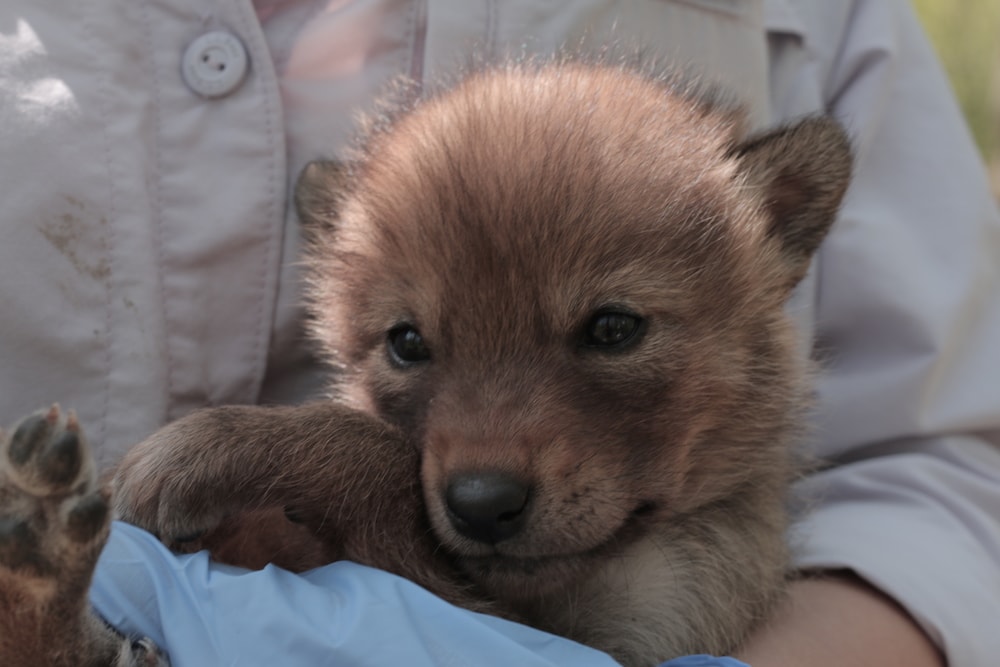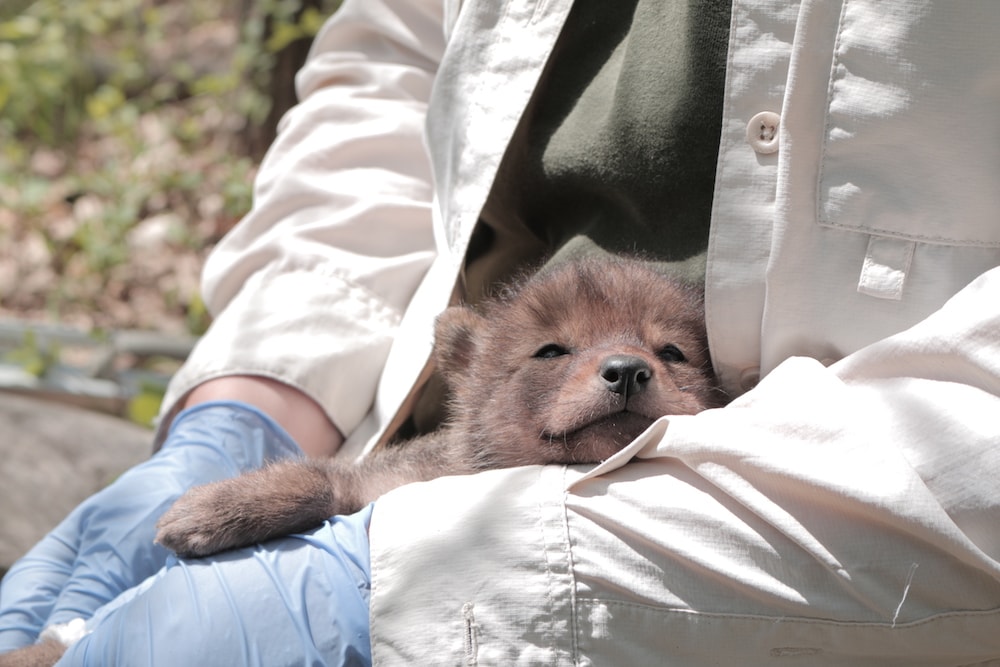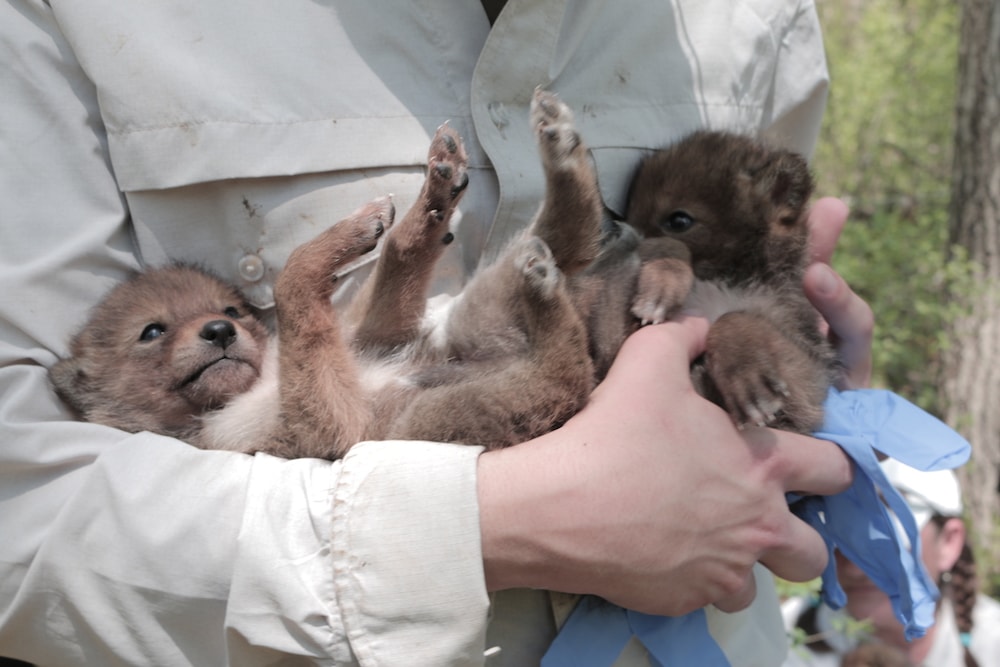The Coyotes Of Chicago
12:29 minutes

At our live event at the Harris Theater in Chicago, we called on WBEZ’s Curious City to help us out. Chicago resident Devin Henderson reached out to the Curious City team including editor Alexandra Solomon to learn more about the coyote population that call Chicago home. Wildlife biologist Chris Anchor, who’s part of Cook County’s Urban Coyote Project, talks about how coyotes made their way into Chicago and how they survive in an urban environment.
The Curious City crew went out with the Urban Coyote Project to track coyote pups outside of the city.


Alexandra Solomon is an editor for WBEZ’s Curious City in Chicago, Illinois.
Devin Henderson is a resident of Chicago, Illinois.
Chris Anchor is a wildlife biologist with the Urban Coyote Project at the Forest Preserve District of Cook County in Chicago, Illinois.
IRA FLATOW: This is Science Friday. I’m Ira Flatow coming to you from the Harris Theater in Chicago.
[APPLAUSE]
You all know that Chicago has a lot going on. And it’s a very busy city. And Chicagoans, well, you’re a very inquisitive bunch. And that’s good. You have a lot of questions about what’s happening around you. And, well, there’s a show for that, and I’m not just talking about Science Friday, that answers your questions, but it’s a good one, too.
I want to introduce our friends from Curious City.
[APPLAUSE]
Yeah. It’s a show about questions that you have that’s produced out of WBEZ here in Chicago. Alexandra Salomon is the editor for Curious City. And Devin Henderson, he’s a curious resident. Thank you for both coming down to talk today. Yeah.
[APPLAUSE]
Alexandra, tell us what Curious City is about.
ALEXANDRA SALOMON: Curious City is about having the public have a say in the kinds of reporting that we do at WBEZ. And we answer questions from the public. They’re about the city, the history, the people who live here. Sometimes it’s something someone’s noticed and hasn’t been able to get an answer from the city. They come to us.
Sometimes it’s just a curious thing that they’ve seen repeated. You know, something on a building that they’ve noticed is in several buildings. And they want to know, where does that come from?
IRA FLATOW: And I’m going to put you on the spot that people put me on the spot about our show.
ALEXANDRA SALOMON: Right.
IRA FLATOW: And they always ask me, hey, what was the most weird thing you’ve ever had or talked about or curious thing?
ALEXANDRA SALOMON: Well, I’d say one of the more– why did boys swim naked in school?
AUDIENCE: [LAUGHTER]
IRA FLATOW: Did you figure–
ALEXANDRA SALOMON: We figured it out.
IRA FLATOW: Are you going to share that with us?
ALEXANDRA SALOMON: It was some weird ideas about hygiene, and specifically boys’ hygiene.
IRA FLATOW: [LAUGHTER] So I was going to ask you next, what has working on Curious City revealed to you about the city, but I don’t want to go–
ALEXANDRA SALOMON: Actually, it turns out, they swam naked in a lot of places, not just here in Chicago. But we ended the practice a lot later than some other cities.
IRA FLATOW: [LAUGHTER] All right, just to stay safe–
ALEXANDRA SALOMON: Yes. Yeah, yeah.
IRA FLATOW: –I’m going to Devin now. I’m going to ask him– you had a question about Chicago.
DEVIN HENDERSON: Yes.
IRA FLATOW: What were you wondering about?
DEVIN HENDERSON: Well, I’m here to ask about coyotes, not to swim naked. I just want to be clear about that.
So I was going down Lake Shore Drive one day in a cab. It was one morning about a year ago. And I saw outside of the window what I first thought was a dog walking down one of the roads along Lake Shore. And then I realized– I grew up in Ohio. A lot of family in the rural part. And so I’d seen a lot of coyotes. And I realized this was a coyote.
So like any good outstanding Chicago citizen, I pulled out my phone and thought, I’ll look up animal control about this. And on their website, they basically said, don’t call us about coyotes unless– [LAUGHTER] right? [LAUGHTER] Don’t call us about coyotes unless there’s a problem.
IRA FLATOW: Wait. Wait a minute. Wait a minute. Wait a minute. Wait.
DEVIN HENDERSON: [LAUGHTER]
IRA FLATOW: So seeing a coyote in Chicago is not considered a problem.
DEVIN HENDERSON: Exactly! That’s what I was surprised to learn, because I thought it would be. So then I submitted a question to Curious City asking about– Chicago actually tracks and kind of protects their coyote population. So I was asking about why Chicago does that and details about that program.
IRA FLATOW: I think it’s interesting. Did you find that as an interesting question?
ALEXANDRA SALOMON: We’ve had a lot of questions about coyotes. I think a lot of people have seen them. A lot of people wanting to know, do they control the rodent population? Did the city bring them here intentionally? So, yeah, it was a very good question.
IRA FLATOW: Did you tell your friends about this? Do you talk it–
DEVIN HENDERSON: Oh, yeah, absolutely.
IRA FLATOW: [INAUDIBLE]?
DEVIN HENDERSON: I posted on Facebook when I saw it, I said something like, is it normal to see coyotes in Chicago? And then a few people chimed in, like, yes, it actually is. There was an occasion about 10 years ago where one wandered into a Quiznos and crawled into the drink cooler to cool off. [LAUGHTER]
IRA FLATOW: Well, if it’s normal to have Cubs in Chicago–
DEVIN HENDERSON: Yeah.
IRA FLATOW: –why not coyotes?
Well, thank you both for taking time to come down and talk about what you do. Thank you very much.
DEVIN HENDERSON: Thank you.
IRA FLATOW: Devin Anderson and Alexandra Salomon, who’s the editor for Curious City. You can hear the show on WBEZ on Thursday afternoons and Saturday mornings.
Now, we’ve been talking about coyotes. We’ve whetted your appetite, right, about coyotes in Chicago. I want to introduce a guest who can tackle that question about the urban coyote. Let me introduce Chris Anchor, a wildlife biologist with the Urban Coyote Project. Welcome to the program.
[APPLAUSE]
CHRIS ANCHOR: Hello.
IRA FLATOW: Tell us a bit about the project. What is the project?
CHRIS ANCHOR: So the Chicago Urban Coyote Project was a systematic attempt to try and understand why coyotes were being found throughout the Chicagoland area, particularly the urban areas.
So I was listening to the question as it was being presented to you here a moment ago. And it was fascinating. Because for approximately 15 years before the inception of the coyote project, which began in the year 2000, the Forest Preserve District that I worked for was accepting coyotes that were found in the city of Chicago and the city of Aurora, because we thought that they were lost.
So we would take those coyotes, and we would take them to the remote areas of the Chicagoland area agricultural areas, and we would put radio collars on them to try and figure out what would happen to them, where they would go. And in the course of approximately 40 animals that we translocated, every single animal went right back to where it was found or died trying to get there.
So what we found out was is that they were not lost at all, that they were actually living amongst us. And we were clueless. We didn’t know what was going on.
IRA FLATOW: There are 2,000 coyotes living in Chicago?
CHRIS ANCHOR: That would be a rough estimate, yes.
IRA FLATOW: It could be more.
CHRIS ANCHOR: Or it could be less, yes.
IRA FLATOW: It could be less. And–
CHRIS ANCHOR: Yeah.
IRA FLATOW: –they all go back home, so you could count them a couple of times. And they showed up early. How far back is the history of them showing up?
CHRIS ANCHOR: Yeah, so coyotes and white-tailed deer, giant Canada geese, beavers all disappeared in the Chicagoland area about 100 years ago, for the most part. And every one of those species returned to the greater Chicagoland area, the southern Great Lakes Basin during the late ’70s, early ’80s. And they all re-established themselves amongst us. They were not reintroduced. They actually are adaptable enough to live amongst us, and actually exploit unused habitats and resources that we did not think that they would be able to do.
IRA FLATOW: Is there a rule of thumb to how to deal if you see a coyote, how to approach it or not approach it?
CHRIS ANCHOR: Yeah, the vast majority of the coyotes are living amongst us, and folks have no idea that they’re even there. Generally, if you run across a coyote, you should just enjoy it. You always want to stay bigger and badder than the coyote. You never want to show fear to any animal in general. Obviously, any coyote or any wild animal that is injured or sick should be avoided.
But of all the coyotes that we’ve handled– we’ve handled over 1,200 coyotes now– literally, a handful of coyotes have gotten in trouble–
IRA FLATOW: Wow.
CHRIS ANCHOR: –actually had negative interface with folks.
IRA FLATOW: Do they have any predators in a city?
CHRIS ANCHOR: Well, an adult coyote has– about the only predator in the city is a GMC pickup truck.
IRA FLATOW: You mean, they get killed by cars and trucks–
CHRIS ANCHOR: Yes.
IRA FLATOW: –more than anything else.
CHRIS ANCHOR: Absolutely. Right. Yep.
IRA FLATOW: Wow. And is there any part of Chicago where they hang out more than any other part of Chicago?
CHRIS ANCHOR: They concentrate in any of the areas that you have some sort of a greenway or someplace where they can move. So it would be along the lakefront. It would be railroad tracks, rightaways, power line rightaways, things like that.
IRA FLATOW: All right. Let’s go to audience questions. Yes. Who’s got a question in the audience? [INAUDIBLE] microphone.
AUDIENCE: I think I know the coyotes that live in Graceland Cemetery and on Ravenswood at Wilson and, like, Wilson and Ravenswood. But are generally the city coyotes bigger than country ones? Because on the farm, the coyotes I see are really scrawny. And the couple that I see on Ravenswood and up there are– they look like big, built German Shepherds. Are they just eating a lot of food? Or are they mating with German Shepherds?
[LAUGHTER]
CHRIS ANCHOR: Yeah, there’s a couple of questions there. The last question about are they mating with German Shepherds. So I’ve been in this job since 1986. And in that time, I’ve literally handled thousands of coyotes. And I’ve never encountered a dog/coyote hybrid. That typically happens when coyotes first extend their range into an area where there are no coyotes and there’s a lack of suitable mates. So for that first generation, you’ll find coyotes and dogs will breed together. But then after that, there’s more than enough coyotes for them to breed.
To answer the first part of your question, coyotes in our area are able to phenotypically express themselves. So whatever genetic potential they have, there’s so much protein and carbohydrate available to them in the course of their life, they tend to be on the large size compared to what an animal would be, say, out in Nebraska or Colorado or Kansas or something like that. It’s the same animal. They just don’t have access to as much protein and carbohydrate as they do here.
IRA FLATOW: When you find a coyote, do you try to relocate it, like you might a raccoon or something, to another area? Or do you leave it in the area?
CHRIS ANCHOR: No, we do not move coyotes. As I indicated in the very beginning, before the urban coyote study, we were moving coyotes, because we didn’t understand what was going on. And the coyotes were responding by going right back to where we caught them or dying trying to get there. So they were not lost. We just didn’t understand what they were doing.
IRA FLATOW: The first time I saw one of the many coyotes in my backyard, which is– I’m fearful that they’re carrying rabies. Like, you know, we’ve always fearful that wild animals. Don’t go near them. They’re carrying rabies. Or coyotes? Carrying rabies.
CHRIS ANCHOR: That’s an excellent question. So it depends on what part of North America you’re in. In the southern Great Lakes Basin where Chicagoland is, rabies is endemic or typically found in bats and skunks. Now, what that means is that although a coyote or any mammal can get rabies, just like a human, they’re not going to transmit it. They’re going to die. So if you’re going to get rabies in the Chicagoland area, chances are it’s going to be a bat.
IRA FLATOW: Well, I know. I know. That’s the good news! That’s the good news.
Thank you. I learned a lot. Didn’t you learn a lot? Wow. Chris Anchor, wildlife biologist with the Urban Coyote Project based out of Chicago.
Also, thanks to Curious City. You can hear that show on WBEZ on Thursday afternoons and Saturday mornings. And you can watch a video that Curious City produced where they search for coyote pups with the Urban Coyote Project. It’s up there on our website at sciencefriday.com.
After the break, we’ll talk about weird mathematical worlds and how abstract math could help us understand the world. Stay with us.
[APPLAUSE]
This is Science Friday from WNYC Studios.
Copyright © 2018 Science Friday Initiative. All rights reserved. Science Friday transcripts are produced on a tight deadline by 3Play Media. Fidelity to the original aired/published audio or video file might vary, and text might be updated or amended in the future. For the authoritative record of Science Friday’s programming, please visit the original aired/published recording. For terms of use and more information, visit our policies pages at http://www.sciencefriday.com/about/policies/
Alexa Lim was a senior producer for Science Friday. Her favorite stories involve space, sound, and strange animal discoveries.